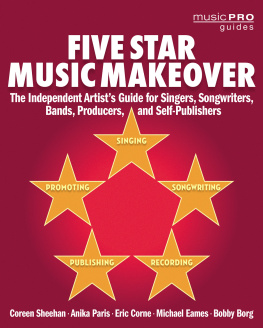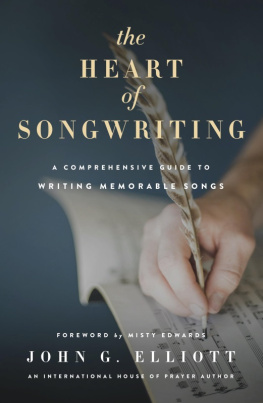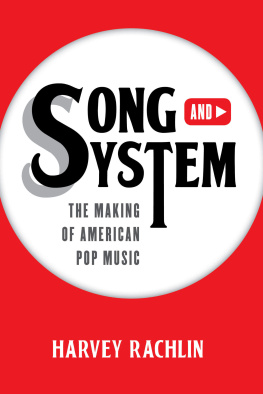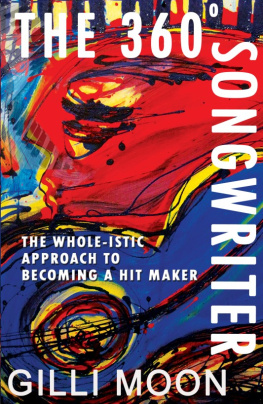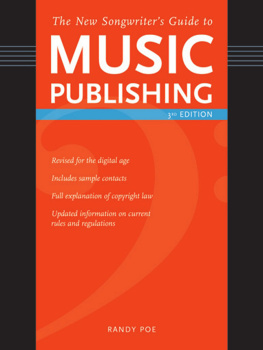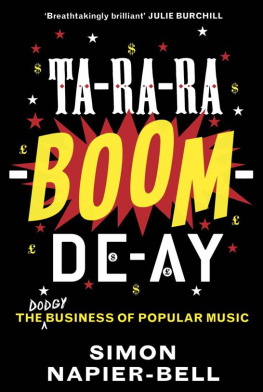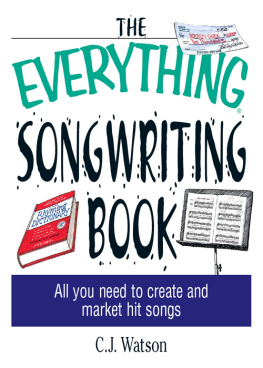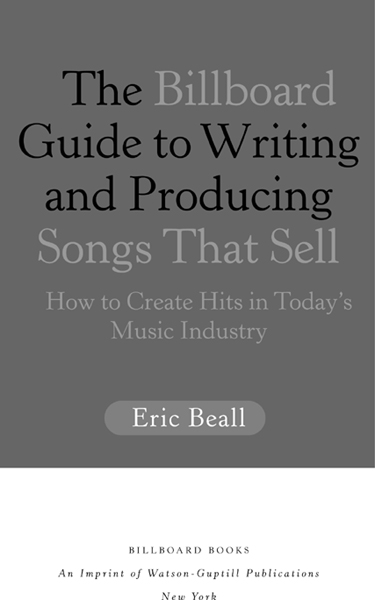With heartfelt thanks to all of the songwriters, producers, artists, and music executives who share their time, talent, and expertise every day, in this crazy game of making hits.
With much appreciation to Tyler Robins and Lisa-Marie Smith for their invaluable assistance.
And with special gratitude to my wife, Cheryl, and my parents, whove been there each step of the way.
Introduction
N o one really knows how many songwriters there are in the United States. We do know that there are roughly 300,000 writer-members of the three primary performing rights organizationsBMI, ASCAP, and SESAC. These are the groups that collect royalty income for songwriters whose work is played on the radio or television. The figure expands significantly when you add the countless aspiring writers whove not yet had their work played anywhere, kids in garage bands across the nation, or your uncle Harry, whos busy concocting another party-stopping ditty for next years holiday get-together.
Suffice it to say, whether youre an accomplished professional, an amateur with grand ambitions, or a musical weekend warrior, you are not alone. Theres close to half a million people out there who share the dream.
At the same time, a glance at Billboard magazine on any given week reveals roughly 275 singles on the major charts (country, urban, pop, rock, and Latin). Each week, approximately twenty of those songs are new releases, hitting one of the charts for the first time. Some will have staying power and continue to climb upward as their popularity increases. Others will drop off the charts a week later, never to be heard from again. Nevertheless, thats about a thousand new songs entering the charts each year.
Given those numbers, you would hardly expect to find people in the music industry wanting for songs. If theres only room for a thousand titles on the charts annually, the industry hardly needs 500,000 songwriters to supply them. In the very best of cases, less than 1 percent of the songwriters in the country will have charting singles in any given year.
Yet if one were to pick up the phone this afternoon and call a handful of music industry professionalsrecord company presidents, producers, publishers, or artist managersand ask them what they need, the same reply would come back, over and over again: Songs! I need a song for
This is not conjecture. As an A&R person, the notorious music-business executive responsible for selecting the material an artist should record, I know firsthand the constant pressure to unearth new songs. Indeed, even after twelve to eighteen months of working on an album, after the recording of twenty, thirty, even as many as ninety songs during the process, many labels and artists are forced to postpone record releases and put projects on hold, while the search continues for just one more song
Whats going on here? Why would an industry find itself searching desperately for the one thing it would seem to have plenty of, all while songwriters face overwhelming odds in the quest to have one of their songs recorded? The answer lies in a breakdown in the chain of supply and demand. The songwriters are supplying the songs. The industry is demanding something else entirely.
No artist, manager, or A&R person searches for just any song. None searches for even a good song. Everyone is looking for a hit song. Unfortunately, most songwriters, and many A&R people, dont exactly know what a hit song is. Fewer still have figured out how to construct one.
This is the bad news. The good news is that for those select few who have studied the craft of songwriting long enough to discern what separates great from good, the rewards are high indeed.
Lets take another look at Billboard. In examining the writer credits on those 275 charting singles in any particular week, we will find the same names cropping up more than once. In fact, there are usually twenty-five to thirty writers who have more than one song on the charts at the same time. This is quite remarkable.
If the chances of landing even one song on the charts are less than 1 percent, how can twenty-five to thirty people each week have several? In fact, some top writers may have three or four songs charting simultaneously.
What explains this? Is it simply a matter of exceptional talent? Certainly, that must be one factor. But most of us in the record business have seen dozens of immensely gifted people release highly touted records and fail to achieve even a glimmer of commercial success. Talent alone is not a ticket to the top of the Hot 100. Is it luck? Doubtful. Luck may land a songwriter one successful song, once in his or her career, but it wont put four songs on the chart in the same week.
If youve ever tried to meet someone at a restaurant whom youre seeing for the first time, youve learned that it helps to have an idea of what he or she looks like. Knowledge is power, and thats especially true when youre chasing something as elusive as a hit song. Songwriters who turn up on the charts again and again know something that most others do not. They understand what makes a hit record. Once they have that knowledge, they can repeat the success that escapes 99 percent of their peers.
The primary objective of The Billboard Guide to Writing and Producing Songs That Sell is to give you the information you need to go from being a songwriter to a hit maker. Whether you are a novice or have been working at your craft for years, to create songs that sell, you have to understand and recognize the nature of a hit song, the role it plays in the music industry, and what it takes to put a song on the radio or to turn an unknown artist into a superstar. No matter what genre you call your own, be it pop, rock, country, hip-hop, R&B, or adult contemporary, you must adapt the perspective of a chart-topping writer and producer and discover the time-tested formulas that lie at the heart of commercial success.
This is not a book about the fundamental technique of songwriting. There are more than enough of those already in existence, and I would encourage you to study them. Our goal is to reinterpret the basics of composition and lyric writing, by approaching each step with the insight and exacting standards of an industry professional. Then well go even further, to examine the all-important hook, where melody, lyric, and rhythm combine to create the twist that can turn your song into a hit.
But can it be done? Arent we really trying to capture lightning in a bottle? Isnt the process by which something gains the fickle favor of the public really a mystery, even to those responsible for putting the wheels in motion? Some would certainly have us believe so.
Brandon Tartikoff, the legendary television executive responsible for The Cosby Show, Miami Vice, Cheers, and LA Law, once said, All hits are flukes. This is not an uncommon sentiment in the record business as well. Ask A&R people to define a hit, and many will raise their eyebrows and assure you that theres no formula and that no one can really predict what will be successful. The irony is that the person telling you this is paid a substantial salary precisely because of his or her supposed ability to pick hits. If hits are entirely random and unpredictable, a company hardly needs a staff of executives to go out and find them.


